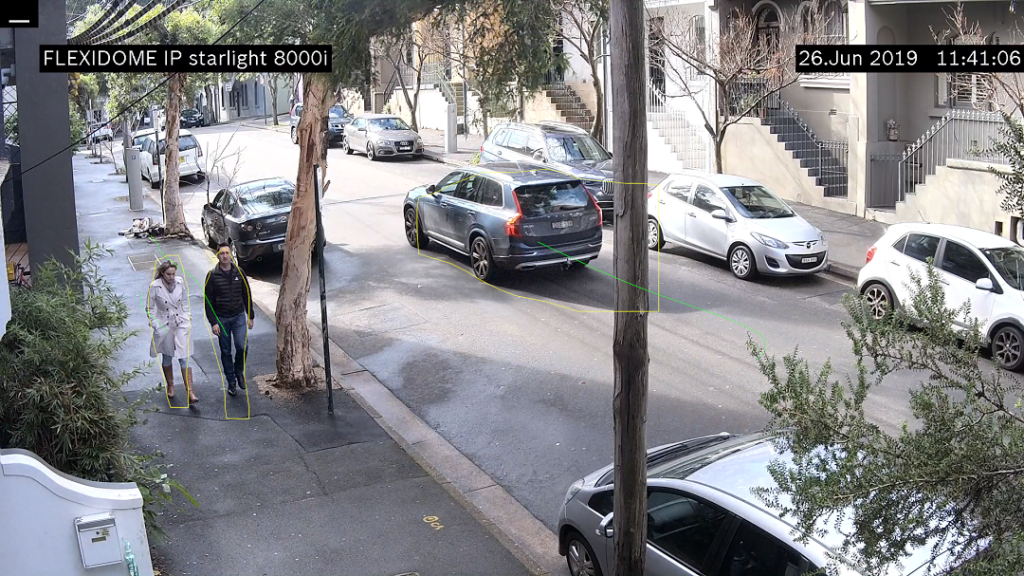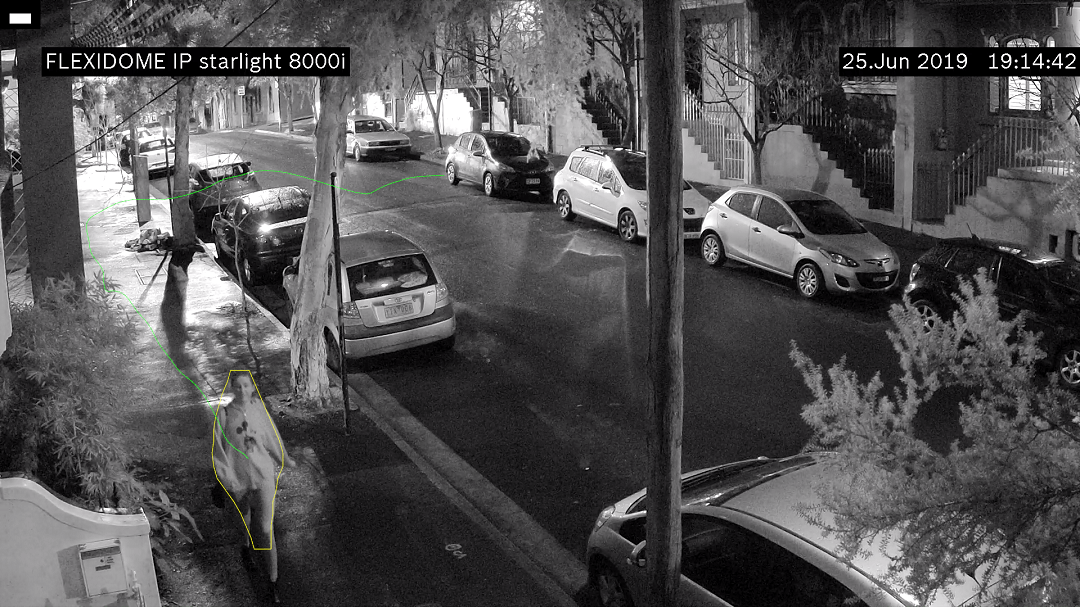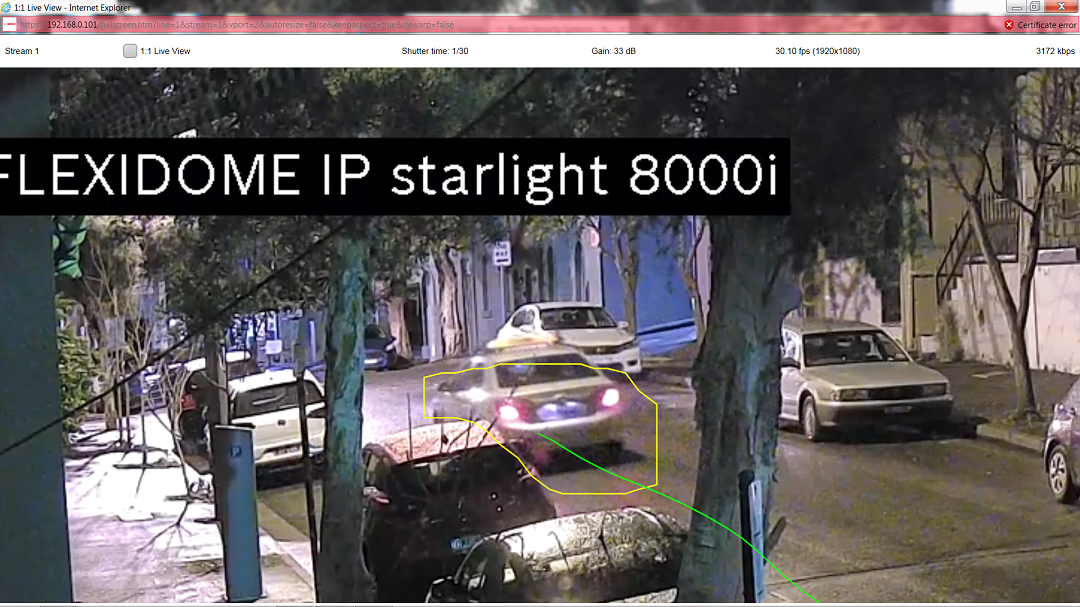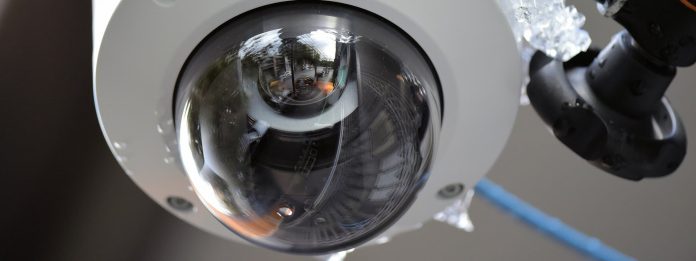Table of Contents – Bosch Camera Review
Bosch 8000i Starlight
Bosch 8000i Starlight Bosch Camera Review – BOSCH’S new FLEXIDOME IP starlight 8000i is available in 1080p, 6MP or 4K versions with 60ips rates for fast moving scenes, H.265 compression and a design optimised for simplicity of installation and operation. It’s nicely built camera with performance to match.
BOSCH’S 8000i is a solid performer that handles the role of robust external dome with aplomb. In fundamental areas such as depth of field, management of backlight and WDR, colour and light balance across a partly shaded scene and motion blur during daytime gloom, performance is excellent. I’m running at a somewhat longer focal length than usual – a bit over 7mm – even so, the 8000i has the ability to deliver faces and plates much deeper into the scene than I’m used to. Night performance is good, but day performance is better – I’m getting fast moving plates at 25 metres.
Before we go on with this Bosch Camera Review, let’s do the specifications. This camera is nicely made in cast aluminium and its construction includes a waterproof connection area and a dehumidifying membrane. The 8000i is IP66 rated against water and dust and IK10 rated against vandalism. Dimensions are 175mm wide x 145mm high and weight is 2.2kg. The dome bubble is clear polycarbonate with a UV blocking anti-scratch coating. Operating temperature range is -50C to 60C. FLEXIDOME IP starlight 8000i range features IP66 rating for water and dust resistance, IK10+ for vandal resistance, has anti-corrosion coating and solid operating temperature range of -50 to +60C.
The motorised pan, tilt and roll lens has pan range of 180 degrees, a tilt range from -55 degrees to 87 degrees and a roll range from -92 degrees to 92 degrees. A PTR dome sounds quirky but when driven in combination with the optical and digital zoom, it makes the 8000i very flexible indeed. The idea of PTR is to make installs easier for techs – you put the camera up and then twiddle via the camera view wizard. However, it also allows you to steer the camera about in real time. Typical Bosch, these functionalities are fast – auto-focus is rocket propelled.

Installers can also use a smart device running Bosch’s Project Assistant app to set up pan, tilt, roll and zoom (PTRZ) functions which we will go into deeper in another Bosch Camera Review. This means you can set and tweak the required field of view without having to go up to the camera on a ladder or scissor lift. This remote commissioning and configuration can be adapted at any stage beyond the initial set-up, making it quick and convenient to adjust the field of view should initial planning requirements change. Pretty neat from Bosch.
Technical Specs
The camera has an IR-corrected P-iris offering 3.9 – 10mm of focal range (10-23mm is an option). The aperture range of F1.6 to F2.6 makes it relatively fast at the short end and reasonable fast at the long. Viewing angle at the wide end is 117 x 59 degrees, while the tele is 37 x 21 degrees. When it comes to resolution options, there are loads of options to limit bitrate – I stick with 1080p and UHD during my testing. The view wizard allows you to tweak mirror image and rotation settings, as well enabling or disabling the camera LED and locking in positioning co-ordinates and mounting height.
Noise Reduction
The 8000i range features Intelligent Dynamic Noise Reduction and intelligent streaming combined with H.265 video compression to reduce bit rate by up to 80 per cent. There’s ONVIF Profile S; ONVIF Profile G; ONVIF Profile T compatibility. You can set up multiple streams in H.264, H.265 and M-JPEG with very configurable frame rate and bandwidth. There’s also a region of interest function. Camera latency is said to be 67 milliseconds – I think mine is a touch higher – about 200, which may be down to my settings. That’s good performance, anyway.
BOSCH’S 8000i is a solid performer that handles the role of robust external dome with aplomb.
Bosch Camera Review
The 8000i has a signal to noise ratio of 55dB for video and 50dB for audio – there’s G.711 audio compression with variable sampling rates, as well as AAC-LC – audio streaming can be full duplex or half duplex. On-board storage is well provided for with dual SD card slots for SDXC/SDHC and SD cards with mirroring and failover storage configurations of recording. A neat feature is an internal RAM, which grabs 5 seconds of pre-alarm recording and holds it until written over.
Security & Networking
Cyber security is serious, with a crypto Coprocessor (TPM) offering RSA 2048-bit, AES/CBC 256-bit, FIPS FIPS 140-2 Level 3 compliance and PKI X.509 certificates. It’s possible to do full end-to-end encryption with a supported VMS using TLS1.0/1.2, AES128, AES256, while local storage can be locked up with XTS-AES. There’s also video authentication checksum options of MD5, SHA-1, SHA-256. All this makes the 8000i and its video streams highly secure.
The 8000i range has Bosch’s Intelligent Video Analytics, which highlight events while ignoring noise created by snow, wind, rain, hail and water reflections – functions include wrong-way detection, traffic counts, monitoring roadsides for parked cars and lots more. Interpreting video data also helps to monitor consumer patterns by identifying hot spots in retail areas. Bosch has been doing analytics at the edge for a very long time and its thoughtful rules are likely to reward installers who want more for their customers than static views.
Driving the Bosch 8000i – Bosch Camera Review
When I picked up the 8000i, the Bosch team surprised me with a pair of domes – one a 1080p and the other a 4K. I had a go of both of these cameras. The 1080p version certainly punches above its resolution. I can’t help feeling the 1080p is a touch brighter as well – not only at night but during the day. In any case, both deliver bedrock operational performance. It’s a rare dome camera that can nail fast moving plates at the distances this Bosch 8000i manages.
Daylight
Daytime performance is strong – there’s slight overexposure on the brighter far side of the street as the camera is exposing for the larger, nearer and darker parts of the scene. Regardless, colour rendition is excellent – a little better on the shaded side but there’s not much in it. Motion blur is invisible to my eye during the day around all moving objects, which is not always the case. Noise is negligible – this applies to the 4K as well as the 1080p camera.


Wide Dynamic Range (WDR)
The 8000i is good with WDR, too. The only thing I do notice in direct sunlight is some veiling flare – whether this is generated inside the lens or by the dome bubble is hard to say. At the same time, there’s no discernible chromatic aberration from the cameras, which is very pleasing. Even areas of rugged contrast around white and silver cars are not provoking CAs. Performance is consistent, too. As the day goes along – and it’s a rainy, glary, bright, dark sort of a day – the camera chugs away, offering faces and plates at unusual depths of field.


I spend a bit of time playing with optical and digital zooms in UHD – I want to know where operational performance with moving plates starts to fall apart – it’s between 50-70 metres. At 30-35 metres you are assured of moving plates and there’s an area in the middle where light, vehicle speed and the contrast of the plate colours feeds into the possibilities. One thing I do notice when driving the UHD camera is that my Dell Optiplex 9020 server is running its fan more than usual.
Low Light Performance


As afternoon goes into rainy night, low light performance in colour is strong, albeit with a slow-ish feeling shutter speed – I’m at 1/60th of a second – it’s an acceptable compromise. I’m still using a longer than usual focal length of around 7.2mm and performance is great – depth of field is excellent, too. Colour rendition is also strong – the camera is managing the strange colour temperatures of the local streetlights superbly. My scene ranges from 4-7 lux, depending on where you are standing, and this camera manages to even things out very well. The levels of detail deep into the scene are great. I can read one-way signs at 70 metres.
I’m using the wizard and the live camera browser to drive the camera – with multiple instances open at a time giving me full screen and tools to hand. I find this offers excellent control – both these applications are easy to navigate. I like monochrome with no direct light in it – the depth of field is perhaps not quite as strong. There’s loads of detail – great contrast – subtle tones – and I can see traffic on Albion St to the point of identifying car type. There’s more than the usual level of detail close up, too. I am getting plenty of identifying characteristics from pedestrians.
There are some ghosts and internal reflections – it’s a dome – but they are not excessive. Considering this is a 1080p camera, I’m happy with performance – I’m getting rain drops on cars at a distance and plenty of detail further in. I’m not getting moving plates at night (static plates are easy out to 25 metres) and faces are only identifiable close up – ID seems to be much better in live mode than it is with my snapshots, which lose detail and contrive to introduce signs of blur I don’t see on the monitor.
Monochrome


Driving the camera through the install wizard is great – it’s meant to make config easier but being able to steer the PT around and then hit optical and digital zoom is so intuitive from a user’s perspective, I don’t want to leave the window. Only the pull of full screen manages to drag me away. Something funny happens at one point – it takes me a while to realise I’m using digital zoom and not optical – only when I go in deep – targeting the street about 50m from the lens do I realise I need to fire up the optical zoom.
Shortly after going into monochrome, I hop back into colour mode. It’s better in my application – the street is just bright enough to carry it. Somehow I feel I’m losing detail in monochrome. I come back to colour via Auto and can’t get out of monochrome that way – I have to bounce the camera into colour then come back to auto. There are some CAs generated by the lens in high contrast areas but it’s not excessive. Unsurprisingly, I notice them more when wound all the way into digital zoom.
Low Light with Colour


At night I find myself waiting to hit snapshot until my targets are standing still – when I do this, I get face recognition out to 8-12m from the lens. Driving the 4K version I find the extra pixels give noticeably more detail. At first, I’m not certain of benefits but when I’ve spent time in 4K mode and then I go back to 1080p, I can see the loss of detail. I think the 1080p has more balanced low light performance – the darker areas are darker in 4K, which you’d expect, give the smaller pixel sizes. Would I choose 4K over 1080p? I’d want both in the same camera, thanks very much.
At night noise levels are very low, there’s tone mapping and blur around moving branches and leaves in low light but the amplification still gives me decent performance in live view. Situational awareness is plentiful – even at 80 metres I get clothing colour and type, bag colour, even specifics of shoes – this is at night. And I can see people crossing the top of Albion St near 100m from the lens – I can see details of their attire, too – gender, general gait. It’s nice work from Bosch.
Conclusion – Bosch Camera Review
After a couple of days of testing in less than ideal weather conditions, I’m delighted with this Bosch 8000i camera. It covers off those key operational things end users want – depth of field, subtle colour rendition, almost no chromatic aberrations, low noise, and low blur – as well as giving the ability to tamp down the effects of strong backlight. Performance at night is impressive, though I could not get moving plates, I got faces within 8 metres at around 4 lux.
During the day the 8000i musters its full strength to deliver faces and plates at extreme distances compared to other cameras of this type. We’ve not tested a mid-focal length dome camera that had the capacity to snare moving plates out past 35 metres and to guarantee face recognition past 25 metres as this one does. You expect good things from a motorised zoom but the Bosch 8000i is better than that. It projects its strong performance a long way into challenging scenes, even at wide lens settings and even in low light. We hope you enjoyed this Bosch Camera Review.
Features of the Bosch 8000i Starlight include:
* 1080p/6MP/UHD options at 60ips
* H.264, H.265, M.JPEG
* Rated to IP66 and IK10
* Operating temperature or -50 to 60C
* 3.9-10mm Motorised Lens (F1.6-F2.6)
* TLS1.0/1.2, AES128, AES256 encryption to VMS
* Bosch Project Assistant App
* Bosch’s Intelligent Video Analytics.
Where is Bosch CCTV made?
Australia and China.
Do Bosch cameras have audio?
Yes, in fact all Bosch IP cameras support motion detection (customisable), audio detection, and anti-masking which increases the level of detection without adding costs. See the above Bosch Camera Review for more info on technical specifications.
More SEN reviews here and don’t miss Bosch solutions at SecTech Roadshow this May.
Bosch Camera Review Bosch Camera Review Bosch Camera Review Bosch Camera Review










We’ve reposted this review as part of updating the new SEN site – going through the images with the new click zoom function reminds me just what a great camera this Bosch 8000i is.
Hi John
Thanks for this amazing review! Have you managed to look at the Bosch 8000i X series cameras?
These come with ultra low light abilities
Hi, Reilly – we haven’t but will ask for a sample. Thanks for reading.